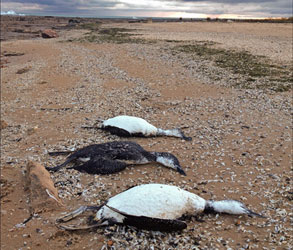Other names: Limberneck, Western Duck sickness, duck disease, alkali poisoning

Photo Credit: Damon McCormick, Common Coast Research & Conservation
Description
Botulism is a severe paralytic disease. It is caused by a neurotoxin produced by the soil bacterium Clostridium botulinum. There are at least seven known types of botulism toxins (Types A – G). The types that usually infect mammals, birds, and fish include Type C, D, and E, with type C being the most common in North America. Since this bacterium normally exists in moist, oxygen-free environments, aquatic and semi-aquatic animals have the highest risk.
On average, 10,000–50,000 birds die each year from avian botulism in the United States, but this number can be as high as 1 million during outbreaks. Severe outbreaks in Indiana are rare.
Table: Types of botulism most frequently found in birds. Common Locations in US
| Botulism Type | Species often Affected | Typical Outbreak Season | Common Locations in US |
|---|---|---|---|
Type C | waterbirds, gulls, shorebirds | September to July | Western states |
Type E | loons, gulls | Spring and Fall | Great Lakes Region |
Transmission
C. botulinum produces the neurotoxin during the process of decay. Animals contract botulism when they ingest the toxin produced by C. botulinum. Ingestion can occur when the animal consumes it directly from the environment or from ingesting prey like infected fish or invertebrates. Birds can also be infected directly from the carcass-maggot cycle. This cycle occurs as fly larvae ingest a carcass infected with botulism and the toxin accumulates in their system. When animals then eat these invertebrates, they consume a concentrated toxin and become infected.
After ingestion, the toxin is absorbed by the small intestine. It is then released into the circulatory system before traveling to all major nerve endings where it causes paralysis of the animal.
Clinical Signs
Avian botulism causes flaccid paralysis. Infected birds often show weakness, lethargy, inability to walk, fly, or hold their head up. Paralysis can lead to drowning before progressing to a more advanced disease state. The extremity of clinical signs depends upon the dose of neurotoxin ingested. Although death can be sudden, signs usually present between 24 hours to two weeks after ingestion. Avian botulism is often difficult to confirm. Reliably identifying cases of avian botulism requires that laboratory tests are run on fresh carcasses.
Wildlife Management Implications
Avian botulism can be managed if the outbreak is not severe. Early warning signals of avian botulism outbreaks are important for controlling mortality rates. You can help track potential outbreaks by submitting a Sick or Dead Animal Report to Indiana DNR if you see a bird exhibiting signs of avian botulism.
Human Health Significance
Avian botulism outbreaks are not typically associated with human illness; nevertheless, consumption of meat from infected animals or exposure of open wounds to contaminated water could result in human infection. The following steps will minimize the risk:
- Always cook fish and poultry to a safe minimum internal temperature before consuming.
- Do not harvest or consume fish that appear to be sick or that are not fighting.
- Do not harvest or consume birds that appear to be sick or dying.
- Do not handle dead fish or birds with your bare hands.
- Properly dispose of carcasses by double bagging and placing them in the trash.
- Do not let your pets eat dead fish or birds.
If you think you were exposed to botulism, please contact a health care provider. You can find additional resources at the Indiana Department of Health and the Centers for Disease Control and Prevention.
Additional Resources
Friend, M., Franson, J. C., & Ciganovich, E. A. (Eds.). (1999). Field manual of wildlife diseases: general field procedures and diseases of birds. US Geological Survey.
Thomas, N. J., Hunter, D. B., & Atkinson, C. T. (Eds.). (2008). Infectious diseases of wild birds. John Wiley & Sons.
